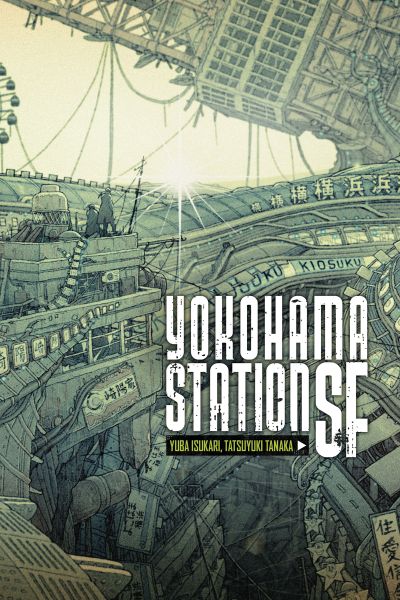Take Me Home
Yokohama Station SF
By Yuba Isukari (Translated by Stephen Paul)

28 Apr, 2021
Yuba Isukari’s 2016 Yokohama Station SF was originally published as Yokohama Eki SF, with illustrations by Tatsuyuki Tanaka. The 2021 translation is by Stephen Paul.
Replicating endlessly, Yokohama Station has spread across Honshu. Life for Insiders — children under six and people over six who have implanted Suika chips — is tolerable. Necessities of life are provided as long as the Insiders do not violate the automated turnstile’s inflexible rules. It’s no utopia but life could be much worse.
Just ask anyone from the Ninety-Nine Steps.
The Ninety-Nine Steps is a tiny community located on a small patch of unassimilated territory just outside the Station. Lacking other resources, the locals are dependent on the Station’s garbage for survival. Although aware of the comparative riches within the Station, nobody in the Ninety-Nine Steps has a Suika; either they never had one or, like former Dodger Alliance Higashiyama, their chip was disabled before they were cast out of the Station. Thus, for the most part, the people of the Ninety-Steps cannot enter the Station.
Suikas are not the only means by which ingress can be attained. Elderly Higashiyama has an 18 Ticket, which confers temporary access to the Station. Having never used the ticket himself, Higashiyama gives it to young Hiroto, who has long been fascinated by the Station he has never entered. There is a price: Higashiyama, who is slipping into senility, asks Hiroto to seek out Exit 42. Higashiyama is rather vague about where Exit 42 might be or what significance it holds.
Hiroto ventures inside the Station, where he discovers a society strictly governed by inflexible algorithms enforced by unthinking machines. There is a functioning economy of sorts, and here and there factions claim authority, albeit constrained by the need to avoid being cast out by the mobile turnstiles. Despite the material support provided to human inhabitants, life within the Station is precarious and unpleasant. At any moment, one might be offend the machines and be cast out to perish.
Assisted by the former leader of the Dodger Alliance, whose ability to avoid the machines was far superior to that of her followers, Hiroto searches for the mysterious Exit 42. Perhaps there he will find some way to free humanity from the machines that rule Honshu.
Or perhaps not; although the automated maps admit Exit 42 exists, they assure the outsider no route to Exit 42 exists.
~oOo~
Yes, it does seem a little unlikely that Hiroto would encounter Higashiyama’s old leader so quickly, or even at all, given that Yokohama Station extends in three dimensions. There are reasons why she might have sought out a neighbourhood near the coast — people exiled from the Station inland end up in desolate little hollows where death by starvation and thirst is inevitable, whereas the coast offers a small chance of survival — but it certainly was lucky for Hiroto that he encountered the one person he wanted to meet in all of populated Honshu.
The endlessly replicating Station was an unintended consequence of the strategies by which the Station attempted to sustain itself despite the challenges of the then-ongoing Winter War (a global conflict that inexorably erased civilization outside Japan). Like a number of calamities found in Japanese works like Yokohama Kaidashi Kikō, the Winter War was not some glorious moment of swift total annihilation that swiftly cleared the board to facilitate survivor adventures. It was a slow, unstoppable catastrophe that became the new normal for as long as it took to remove almost all human civilization from the face of the Earth.
I don’t know why I encounter this sort of slow-motion end of the world more frequently in Japanese SF than elsewhere. The deliberate pace facilitates a focus on how people adapt to being slowly boiled like frogs, as opposed to having the Old Order quickly and efficiently swept away to make room for thrilling adventures. This specific example is more towards the Girls Last Tour end of the optimism scale than YKK, what with the increasingly inhospitable world humans occupy, not to mention the certainty, thanks to certain actions taken by Hiroto, that grand changes will sweep across Honshu, changes for which Insiders are ill-prepared.
The focus here is on the setting rather than the characters, who are for the most part … functional. Nevertheless, the narrative kept my interest.
Yokohama Station SF is available here (Amazon US), here (Amazon Canada), here (Amazon UK), here (Barnes & Noble), here (Book Depository), and here (Chapters-Indigo).
